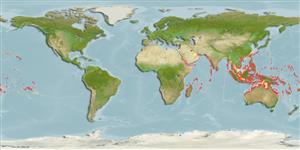Environment: milieu / climate zone / depth range / distribution range
Ekologi
laut berasosiasi dengan karang; nir-ruaya; kisaran kedalaman 0 - 40 m (Ref. 37816), usually 1 - 15 m (Ref. 90102). Tropical; 24°C - 28°C; 29°N - 34°S, 33°E - 122°W (Ref. 5222)
Indo-Pacific: Red Sea to Durban, South Africa and eastward to French Polynesia and the Pitcairn group, north to the Ryukyu and Ogasawara islands, south to northern Australia and Lord Howe Island. May be confused with Cephalopholis cyanostigma.
Length at first maturity / Size / Weight / umur
Maturity: Lm ?, range 22 - ? cm
Max length : 60.0 cm TL jantan/; (Ref. 11441); common length : 40.0 cm TL jantan/; (Ref. 5450)
Duri punggung (Keseluruhan (total)) : 9; duri punggung lunak (Keseluruhan (total)) : 15 - 17; Duri dubur: 3; Sirip dubur lunak: 9. This species is distinguished by the following characters: greatest body depth 2.7-3.3 in SL; dorsal soft rays usually 16-17; pectoral fin rays usually 16-17; longitudinal scale series 95-110; caudal fin rounded; pelvic fins short , 1.9-2.4 in head length. Colour of body dark brown, with small black-edged blue spots; often with 5-6 pale bars on rear part of body and a large pale area over the chest (abdominal/pectoral region) (Ref. 39231, 90102).
A generally common species (Ref. 9710). Adults are benthic and benthopelagic in a variety of coral habitats (Ref. 58534, 58302) from tide pools to depths of at least 40 m; preferring the 1 to 10 m reef zone. Juveniles prefer shallow, protected coral thickets (Ref. 37816). Mature adults are found in social units comprising up to 12 adults, including 1 dominant male and each group occupies a specific area (up to 2,000 sq. m.) that is defended by the territorial male and subdivided into secondary territories, each inhabited by a single female (Ref. 39231). At times, they may also be solitary (Ref. 90102). Adults feed mainly on fishes (75-95%) and to a lesser extent on crustaceans. In the Red Sea, they feed early in the morning and late afternoon (Ref. 6775) but in Madagascar, they appear to feed more at night (Ref. 6774). They are implicated in ciguatera at some of the islands in the Pacific region. They can be seen in Hong Kong live fish markets (Ref. 27253). They are important to artisanal fisheries throughout the Indo-West Pacific region and often caught with hook-and-line, spear, and in traps (Ref. 39231). Minimum depth reported taken from Ref. 128797.
Heemstra, P.C. and J.E. Randall, 1993. FAO Species Catalogue. Vol. 16. Groupers of the world (family Serranidae, subfamily Epinephelinae). An annotated and illustrated catalogue of the grouper, rockcod, hind, coral grouper and lyretail species known to date. Rome: FAO. FAO Fish. Synop. 125(16):382 p. (Ref. 5222)
Status IUCN Red List (Ref. 130435)
ancaman kepada manusia
Reports of ciguatera poisoning (Ref. 4690)
penggunaan manusia
Perikanan: komersial; Ikan buruan: ya; Akuarium: Komersial
Alat, peralatan
laporan khas
muat turun XML
Sumber internet
Estimates based on models
Preferred temperature (Ref.
123201): 24.9 - 29.3, mean 28.4 °C (based on 3533 cells).
Phylogenetic diversity index (Ref.
82804): PD
50 = 0.5000 [Uniqueness, from 0.5 = low to 2.0 = high].
Bayesian length-weight: a=0.01230 (0.01059 - 0.01430), b=3.04 (3.01 - 3.07), in cm total length, based on LWR estimates for this species (Ref.
93245).
Trophic level (Ref.
69278): 4.5 ±0.0 se; based on diet studies.
Daya lenting (Ref.
120179): sedang, Waktu penggandaan populasi minimum 1.4 - 4.4 tahun (Preliminary K or Fecundity.).
Fishing Vulnerability (Ref.
59153): Moderate vulnerability (44 of 100).
Climate Vulnerability (Ref.
125649): High to very high vulnerability (72 of 100).
Nutrients (Ref.
124155): Calcium = 35.8 [20.4, 60.7] mg/100g; Iron = 0.489 [0.277, 0.892] mg/100g; Protein = 18.7 [16.9, 20.4] %; Omega3 = 0.152 [0.098, 0.235] g/100g; Selenium = 35.2 [19.9, 59.3] μg/100g; VitaminA = 148 [53, 474] μg/100g; Zinc = 0.673 [0.495, 1.087] mg/100g (wet weight); based on
nutrient studies.
